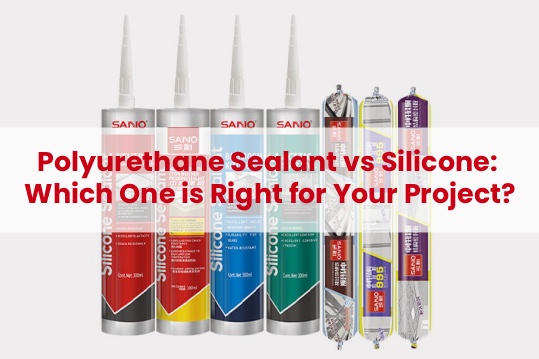When it comes to choosing the right sealant for your project, there are many factors to consider. Two popular types of sealant are polyurethane and silicone. While both have their benefits, they also have different properties that make them better suited for certain applications. In this article, we’ll discuss “polyurethane sealant vs silicone” and help you decide which one is right for your project needs. We’ll also introduce SANVO, a Chinese manufacturer of industrial adhesives and sealants.

Introduction
With more than a decade of experience, SANVO is a leading Chinese maker of industrial adhesives and sealants. Among the many goods we carry are silicone and polyurethane sealants, epoxy adhesives, threadlockers, and much more. We have earned trust and loyalty from customers because to our dedication to providing only the finest goods at reasonable pricing.
SANVO does more than only sell products; we also offer bespoke formulation services to cater to our clients’ specific requirements. Based on your specifications and intended use, our expert chemists may create bespoke formulas.
What is Polyurethane Sealant?
Polyurethane sealant is a highly durable adhesive that can be used for a variety of applications, including bonding, sealing, and filling gaps. It is made from a combination of polyurethane resin and a curing agent, which causes it to harden and become strong over time. Polyurethane sealant is known for its high strength, flexibility, and resistance to moisture, making it ideal for use in construction and automotive industries.
What is Silicone Sealant?
Silicone sealant is a versatile adhesive that is made from silicone polymer. It is commonly used for sealing gaps and joints in surfaces such as glass, metal, plastic, and rubber. Silicone sealant is known for its durability, flexibility, and resistance to high temperatures, making it ideal for use in automotive and industrial applications.
Polyurethane Sealant vs Silicone: Which One to Choose?
Now that we know what polyurethane and silicone sealants are, how do we decide which one to use? Here are some guidelines:
– Use polyurethane sealant for applications where high strength and durability are required, such as construction and automotive industries.
– Use silicone sealant for sealing gaps and joints in areas with high moisture levels, such as bathrooms and kitchens.
– Consider the surface you will be working on. Polyurethane sealant is best suited for surfaces such as metal, concrete, and wood, while silicone sealant works well on non-porous surfaces such as glass and plastic.
Conclusion
When it comes to choosing between polyurethane sealant vs silicone, it’s important to consider the properties of each and the specific needs of your project. If you’re looking for a highly durable adhesive with high strength and resistance to moisture, polyurethane sealant may be the right choice. If you need to seal gaps and joints in areas with high moisture levels, silicone sealant is the way to go.
Regardless of your needs, SANVO has everything you need to get the job done right. With our commitment to quality and customer satisfaction, you can trust them to deliver the best products and services for your project needs.

